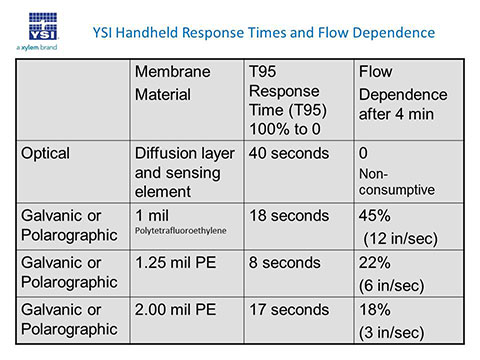What Dissolved Oxygen Membrane Do I Use?
Dissolved oxygen meters with electrochemical sensors (polarographic or galvanic) require a membrane to operate properly. An electrochemical membrane is a thin semi-permeable material, stretched over the sensor that isolates the electrodes from the environment while allowing gases to enter. YSI offers several different types of dissolved oxygen membranes of varying design, thickness, and material.
The two types of membrane designs include a traditional, sheet-like stretch membrane that is held in place by an o-ring and the plastic screw-on cap membrane that has the membrane material pre-stretched at the factory.
(Learn more, A Step-by-Step Guide to Installing Stretch-Over DO Membranes and Is It Hard to Change a Dissolved Oxygen Cap Membrane?)
The membrane's material and thickness affect the sensor's flow dependence and response time. The table below shows the various membrane thicknesses and materials offered by YSI and their corresponding response times, flow dependence, and required flow rates.

* YSI studies have shown that stirring an optical sensor can lower its response time. For example, using a magnetic stirrer or stir bar could result in an optical response time of 22 seconds or less for T95.
Note - The response time in this table is listed as T95 which is the amount of time it takes for the sensor to get to 95% of the desired reading when moved from a 100% saturated sample to a 0 oxygen environment.
The type of membrane that can be used with a particular instrument is dictated by the sensor type in use and by the instrument's microprocessor.
Using an incorrect membrane could result in erroneous readings so care should be taken when ordering replacement membranes for your dissolved oxygen sensors. Refer to the Membrane Selection Guide to help order the proper membrane for a specific instrument and sensor. I
f you have an instrument that can use more than one type of membrane, determine which option is best for your application based on the response times and required flow rates of the membranes available for your instrument. For instruments that can use more than one membrane, it should be noted that the instrument must be properly configured for the membrane installed in order to obtain accurate readings.

Additional Blog Posts of Interest:
Is It Hard to Change a Dissolved Oxygen Cap Membrane?
A Step-by-Step Guide to Installing Stretch-Over DO Membranes
What Is Affecting Your Dissolved Oxygen Measurements? Part 1 of 4
5 Easy Steps: Replacing the Optical DO Sensor Cap on YSI EXO Sondes